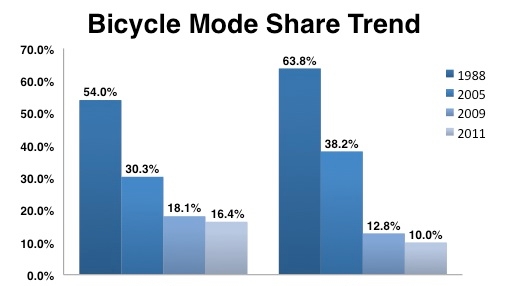Key Recommendations
- Preserve and increase the contribution of walking and cycling.
- Improve the experience of walking/cycling by building smaller block sizes and developing secondary road networks; improving the quality of feeder roads, improving basic facilities such as toilets, lights, trees, and benches; and improving safety along key arterial corridors.
Bicycling and walking are important aspects of city life. They are not only true low-carbon urban mobility choices; they are also critical elements of any modern urban mobility system.
From a planner’s perspective, walking and cycling trips are space efficient, require low investments, and offer mobility without imposing external costs of noise, pollution, congestion, or accidents. In dense urban environments, walking and cycling often can be the most efficient modes of urban mobility. For users, they offer mobility at low cost, with the potential of health and lifestyle benefits.
In all cities, these modes are the mainstay for short trips and often the only sources of mobility for the poor. In addition, walking and cycling are critical for providing last-mile access and connecting to public transport networks.
Though many cities globally—from New York and Buenos Aires to Paris and Copenhagen—actively promote and support cycling and walking as essential elements of their transport strategies, most would be envious of the situation in Chinese cities in terms of the share and importance of these modes.
Chinese cities have a long and important tradition of cycling and walking. Even today, between 50 percent and 60 percent of trips in most Chinese cities are made on foot and by bicycle (see figure above). However, in most Chinese cities the trend is negative, and as shown in figure above, bicycle use in particular has been decreasing precipitously in recent years.
China, as late as the 1980s, was often referred to as the “Bicycle Kingdom,” with bicycles dominating traffic in cities across the country. That is no longer the case, and economic growth, changing cultural perceptions, rapid motorization, spatial growth, and changes in trip patterns have all resulted in sharp declines in cycling and walking.
Walking and cycling, however, remain important modes and the challenge for Chinese cities now is how to at least preserve, and perhaps increase, the share of trips made using these non-motorized modes.
Conditions for both pedestrians and cyclists, however, have been deteriorating across Chinese cities in the last few years. This is due to a combination of factors, including the lack of policies prioritizing these users, cities sacrificing space for non-motorized traffic to be used for motorized traffic, the spatial growth of cities resulting in longer trips, and specific difficulties related to the big arterial roads of a typical Chinese city.
Cities can take actions to improve conditions and preserve the quality of infrastructure for cyclists and pedestrians. An overarching issue in this respect is the need to obtain strong policy-level support and guidance from the national government supporting and emphasizing the role of cycling and walking as part of the sustainable transport solution in China’s cities.


